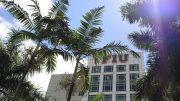Students at the Modesto Maidique Campus have one intramural field.
Available space for intramural competition is so bad, additional leagues were even prevented from being created, said Alexis Calatayud, president of the Student Government Council at MMC.
And all practices for the football team take place on the Ocean Bank field at FIU stadium, an artificial turf field.
“It is impossible to accommodate the recreational needs of all of these sports,” according to a public document that details a project to add two more fields.
But they will come with a hefty price tag.
At their Dec. 9 meeting, the University’s Board of Trustees approved the construction of two more football-field-sized grounds for intramurals and practices for the football team.
The entire cost of the project: $8.9 million.
“But that’s only worse case scenario,” said Chief Financial Officer Kenneth Jessell to Student Media.
Jessell said the terms of the construction project have yet to be completed and administrators hope to be able to negotiate a lower price.
Students will provide $500,000 in money collected from their activity and service fee, and the University will pay the remaining $8.4 million from unrestricted fund balances, Jessell said.
Athletics will repay 50 percent of the project cost through an internal loan and/or fundraising, such as the naming of the fields, the document states.
Jessell said during the meeting that most of the costs are to move Southwest 17th Street.
However, according to the document, that part of the project costs $953,190. The combined costs of the two fields is $1.3 million.
During the Finance & Audit Committee meeting only one member disapproved of the fields, specifically the timing of the project.
Kathleen Wilson, chairwoman of the Faculty Senate, said she is for the idea of more fields and understands there are safety and access issues. But as she is also chairwoman of the University’s Student Success Committee, she feels the money for the project could be used elsewhere.
“I do want to support athletes,” Wilson said to Student Media. “But the timing is not great right now.”
Wilson cited the University’s strategic plan, “FIUBeyondPossible2020,” which has goals for student success that include improving student retention, the six-year graduation rate and preparing graduates for the workplace.
Wilson said the number of students who would directly benefit from more intramural fields – 380 to 400 – is too small of a subset.
“I wanted to go on record for the sake of the other 50,000,” Wilson said.
The project currently includes: one natural turf field, one artificial turf field, lighting systems on each field, fencing, demolition/construction of Southwest 17 Street, replacement parking and relocation of existing trees.
The new fields will be available to both student-athletes and students who play intramural sports: flag football, lacrosse, rugby and soccer.
The Recreation and Wellness Center oversees the intramural and club sports program.
Students will be able to use the natural turf field for intramural games when the football season ends, except when other teams within Athletics need it for practice.
The Panthers are the only team in Conference USA without practice fields. Adding the fields will allow the football team to practice on both artificial and natural grass and to conduct simultaneous practices for the offensive and defensive teams.
Practicing on natural grass is considered better as certain types of injuries may be reduced, and natural grass is 10-15 degrees cooler than artificial turf.
Calatayud said to Student Media that during her time in SGA she’s always heard complaints about not enough space for intramurals. The last games start at 12 a.m., she said.
“Intramurals are really an essential part of the student experience,” said Calatayud, co-chairwoman of the Student Success Committee.
Albert Maury, outgoing chairman of the Board of Trustees, said the fields are necessary to prevent future injuries to football players.
He said injuries both in 2015 and in prior years happened because of the artificial turf field.
“The thing that got to me was when they told me the amount of injuries that are happening to these students,” Maury said to Student Media.
Maury said he was told about 20 to 50 percent of the injuries that occurred were because of the artificial turf field.
“So I see it as a need,” he said. “And I do not have an issue sacrificing some money for something that will improve the safety of our student athletes.”
Maury made a “strong request” to University President Mark Rosenberg during the Board meeting to ask Miami-Dade County officials again to be able to use the three soccer fields behind the football stadium.
He said he is open to the idea of the University spending money to improve those fields if necessary.
“I think it’ll be a win-win for our community and for us if we can do that.”






Would it not be a smart idea to multi-task and make either one of these fields have a Conference eligible track and field facility for the track team that has to drive all over for practices. Plus it could be used by the overall student body when practice isn’t going on. Also could bring money during track meets.
In regard to Dr. Wilson’s comment regarding the number of intramural participants who would use the field, the actual number is closer to 5,000 – from flag football, soccer, ultimate frisbee, and kickball activities throughout the year. In addition, there are 6 Sport Clubs that could use the field – men’s & women’s rugby, women’s lacrosse, quidditch, and men’s & women’s soccer – totaling another 100+ users, plus the collegiate club teams that would visit for competition against them. I believe Dr. Wilson may have been referring to the total number of varsity athletes at FIU.